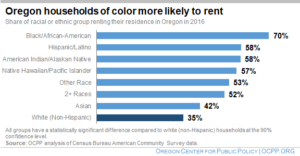This report is available as a PDF: One in Three Oregon Families Struggle to Afford Housing
Many Oregonians are struggling to afford safe and stable housing. Renters — who are disproportionately Oregonians of color — are the most likely to suffer from high housing costs. Many homeowners also struggle to keep a roof over their heads. Not surprisingly, housing costs weigh more heavily on low- and moderate-income households.
For Oregonians struggling to pay for their rent or mortgage, the cost of housing can make it hard to afford other basics such as healthy food and child care. In the worst cases, unaffordable housing costs increase rates of homelessness in Oregon.[1]
Housing instability, in turn, undermines the physical and mental health of families, as well as the ability of children to succeed in school.[2]
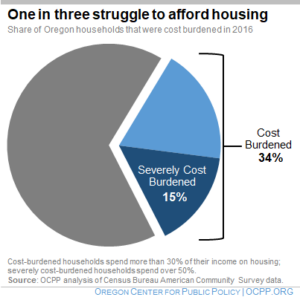
The Department of Housing and Urban Development defines households that spend 30 percent or more of their income on housing costs as “cost burdened.”[3] Also, researchers consider households that spend 50 percent or more of their income on housing as “severely cost burdened.”[4]
In 2016, one-third of Oregon households — about 530,000 households — struggled to afford housing. Of that total, 15 percent were severely cost burdened, keeping less than half of their paychecks to afford all the other necessities, including health care, food, and transportation costs.
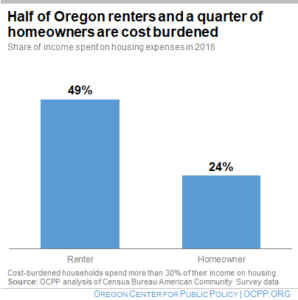
Renters are more likely to be cost burdened than homeowners. In 2016, only about half of all renter households were able to reasonably afford their rent and utilities. Of those, nearly one in four spent more than half of their income on housing costs, and are considered severely cost-burdened. There were over 151,000 severely cost-burdened renter households in Oregon.
A smaller share of homeowners pay too much for housing. In 2016, about 24 percent of homeowners — about 234,000 in total — were cost burdened. Of those, more than a third – about 92,000 or 9 percent – were severely cost burdened.
Housing costs weigh more heavily on communities of color, as they are more likely to be renters and have lower incomes.[5] While one-third (35 percent) of Oregon’s non-Hispanic white households are renters, majorities of all communities of color rent, except for Asian Americans. This is especially significant for Oregon’s Black/African-American community, where seven in ten households are renters, double the rate of non-Hispanic white Oregon households.
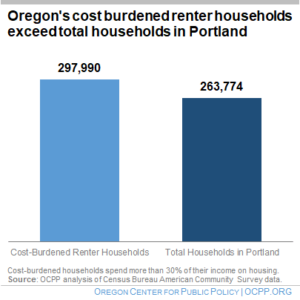
In 2016, there were more renter households in Oregon that spent 30 percent or more of their income to pay for housing costs than the total number of households in Portland.
That year, there were nearly 298,000 cost-burdened renter households in Oregon, compared to 264,000 total households in Portland.[6]
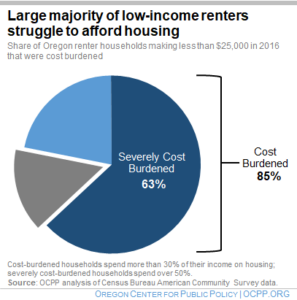
Not surprisingly, households with lower incomes are much more likely to struggle to afford a safe and stable rental. Nearly two in every three renting households making less than $25,000 in 2016 spent more than half of their income on housing.
When adding the renter households paying between 30 percent and 50 percent of their income in housing costs, about 85 percent of all renter households making less than $25,000 were cost burdened.
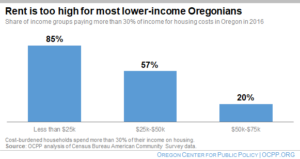
Moderate-income Oregonians also struggle with housing costs. Over half of Oregon renter households making between $25,000 and $50,000 per year were cost burdened in 2016.
Conclusion
Affording a safe and stable place to live is a challenge for many Oregonians, particularly those who rent. The data confirms that Oregon’s housing affordability crisis is real.
[1] Poverty and lack of affordable housing are the leading causes of homelessness in America, according to the National Law Center on Homelessness & Poverty, Homelessness in America: Overview of Data and Causes.
[2] “Housing instability negatively affects the health of children and caregivers,” Science Daily, January 22, 2018; National Poverty Center, Housing Instability and Health: Findings from the Michigan Recession and Recovery Study, March 2010; Diana Bowman et. al., Summary of the State of Research on the Relationship Between Homelessness and Academic Achievement Among School-Aged Children and Youth, National Center for Homeless Education, January 2012.
[3] The costs include the full cost of housing, including any mortgage, rent, or utility costs. To determine the percent of cost-burdened and severely cost-burdened Oregon households, this analysis used the methodology established by the Center on Budget and Policy Priorities.
[4] The U.S. Department of Housing and Urban Development (HUD) uses the 30 percent threshold to define cost burdens. The “severely cost burdened” description is widely used in the literature. Mindy Ault, Center for Housing Policy’s Housing Landscape 2016, February 2016; Joint Center of Housing Studies of Harvard University, The State of the Nation’s Housing 2017, June 2017; HUD Office of Policy and Development Research EDGE Article, Rental Burdens: Rethinking Affordability Measures, September 2014.
[5] Comparisons between shares of racial or ethnic groups who are renter households only tests for statistically significant differences between communities of color and white (non-Hispanic) households, not between different communities of color. The test was conducted at the 90 percent confidence level. For data on income levels for communities of color, see Oregon Center for Public Policy, “Despite overall economic gains, communities of color in Oregon lag economically,” news release, September 14, 2017.
[6] U.S. Census Bureau, 2016 American Community Survey 1-Year Estimates, question S1101 for Portland city, Oregon.


